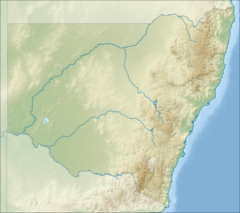Fingal Head Light

Fingal Head Light, 2009
|
|
|
New South Wales
|
|
| Location |
Fingal Head New South Wales Australia |
|---|---|
| Coordinates | 28°12′0.07″S 153°34′14.98″E / 28.2000194°S 153.5708278°ECoordinates: 28°12′0.07″S 153°34′14.98″E / 28.2000194°S 153.5708278°E |
| Year first constructed | 1872 (post light) |
| Year first lit | 1878 |
| Automated | 1920 |
| Foundation | concrete slab |
| Construction | sandstone masonry tower |
| Tower shape | cylindrical tower with balcony and lantern |
| Markings / pattern | white tower and lantern |
| Height | 23 feet (7.0 m) |
| Focal height | 80 feet (24 m) |
| Current lens | fourth order catadioptric |
| Light source | mains power |
| Intensity | white: 37,000 cd red: 9,000 cd |
| Range | white: 17 nautical miles (31 km; 20 mi) red: 14 nautical miles (26 km; 16 mi) |
| Characteristic | Fl WR 5s. |
| Admiralty number | K2844 |
| NGA number | 111-5872 |
| ARLHS number | AUS-073 |
| Managing agent | Australian Maritime Safety Authority |
| Heritage | Department of Conservation & Land Management |
Fingal Head Light is an active lighthouse located at Fingal Head, New South Wales, Australia, a headland about 5 kilometres (3.1 mi) south of Point Danger, which marks the Queensland border.
The station was first established on 19 February 1872, a wooden pole structure of approximately 30 feet (9.1 m), holding a fixed kerosene wick burner which shone a fixed white light with an intensity of 1,000 cd. It was describe by a daughter of William Arnold, the first lighthouse keeper, as being shaped like a large meat safe, mounted on a wooden structure resembling a pigeon loft. The keeper had to row from the Tweed Heads Pilot Station each day and light the lantern at sunset, and a hut was constructed for him to stay in.
In October 1878 the Maritime Board of New South Wales decided to construct a modern lighthouse at the location. It was the third of five lighthouses of similar design designed by James Barnet in 1878–80, the other four being Richmond River Light, Clarence River Light (now demolished), Tacking Point Lighthouse and Crowdy Head Light. It originally had a porch and an serving as oil room. A four-room, single-storey lighthouse keeper's house was constructed about 20 metres (66 ft) northwest of the tower. The lighthouse and keeper's cottage were constructed by Joseph William Mortley and Shepherd who were successful with their government tender.
On 15 June 1920 the light was converted to an automatic carbide lamp (acetylene gas) apparatus, with an intensity of 1,500 cd, and altered to group flashing. Soon after, the station was demanned and all buildings other than the tower were demolished.
...
Wikipedia

